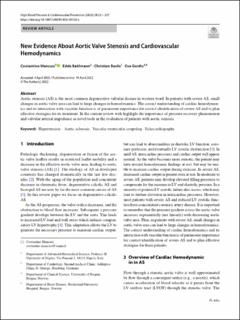| dc.contributor.author | Mancusi, Costantino | |
| dc.contributor.author | Bahlmann, Edda | |
| dc.contributor.author | Basile, Christian | |
| dc.contributor.author | Gerdts, Eva | |
| dc.date.accessioned | 2022-08-11T07:32:20Z | |
| dc.date.available | 2022-08-11T07:32:20Z | |
| dc.date.created | 2022-04-30T14:12:02Z | |
| dc.date.issued | 2022 | |
| dc.identifier.issn | 1120-9879 | |
| dc.identifier.uri | https://hdl.handle.net/11250/3011211 | |
| dc.description.abstract | Aortic stenosis (AS) is the most common degenerative valvular disease in western word. In patients with severe AS, small changes in aortic valve area can lead to large changes in hemodynamics. The correct understanding of cardiac hemodynamics and its interaction with vascular function is of paramount importance for correct identification of severe AS and to plan effective strategies for its treatment. In the current review with highlight the importance of pressure recovery phenomenon and valvular arterial impedance as novel tools in the evaluation of patients with aortic stenosis. | en_US |
| dc.language.iso | eng | en_US |
| dc.publisher | Springer | en_US |
| dc.rights | Navngivelse-Ikkekommersiell 4.0 Internasjonal | * |
| dc.rights.uri | http://creativecommons.org/licenses/by-nc/4.0/deed.no | * |
| dc.title | New Evidence About Aortic Valve Stenosis and Cardiovascular Hemodynamics | en_US |
| dc.type | Journal article | en_US |
| dc.type | Peer reviewed | en_US |
| dc.description.version | publishedVersion | en_US |
| dc.rights.holder | Copyright 2022 the authors | en_US |
| cristin.ispublished | true | |
| cristin.fulltext | original | |
| cristin.qualitycode | 1 | |
| dc.identifier.doi | 10.1007/s40292-022-00520-x | |
| dc.identifier.cristin | 2020324 | |
| dc.source.journal | High Blood Pressure & Cardiovascular Prevention | en_US |
| dc.source.pagenumber | 231-237 | en_US |
| dc.identifier.citation | High Blood Pressure & Cardiovascular Prevention. 2022, 29, 231-237. | en_US |
| dc.source.volume | 29 | en_US |

